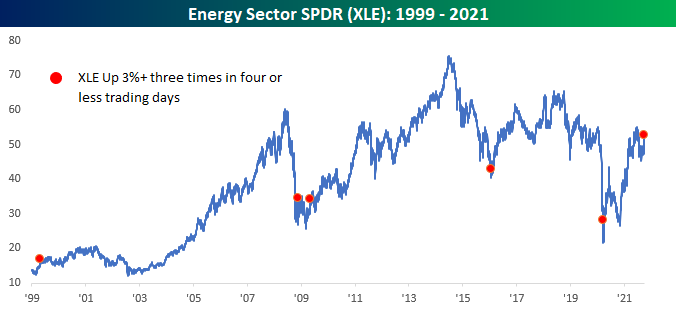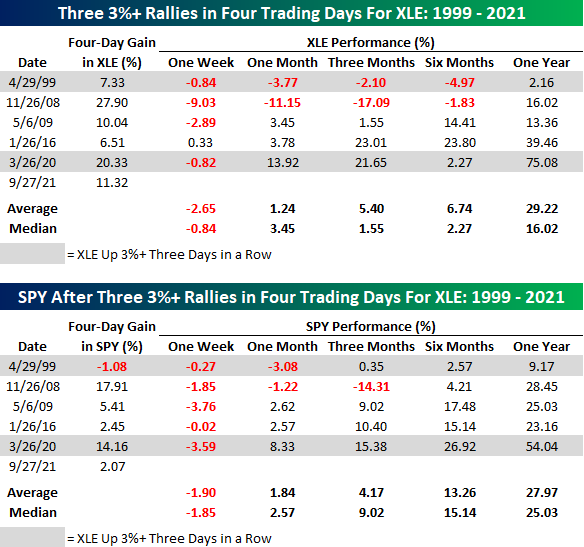Market Insights: High Energy
Milestone Wealth Management Ltd. - Oct 01, 2021
Macroeconomic and Market Developments: North American markets were steeply lower this week. In the U.S., the Dow Jones Industrial Average decreased 1.36% and was down 0.23% for the third quarter that ended on Thursday. The S&P 500 Index decreased
Macroeconomic and Market Developments:
- North American markets were steeply lower this week. In the U.S., the Dow Jones Industrial Average decreased 1.36% and was down 0.23% for the third quarter that ended on Thursday. The S&P 500 Index decreased 2.20% and was down 0.30% for Q3. In Canada, the S&P/TSX Composite Index decreased 1.22% and was down 0.47% for Q3.
- The Canadian dollar was slightly higher this week, closing at 79.14 cents vs 79.08 cents last Friday.
- Oil prices were strong again this week. US West Texas crude closed at $75.76 vs $73.96 last week, and the Western Canadian Select price closed at $63.60 vs $62.19 last week.
- Gold prices were slightly higher this week, closing at $1,759 vs $1,748 last Friday.
- On Tuesday, Agnico Eagle (AEM) and Kirkland Lake Gold (KL) announced an all-stock merger of the two companies. The new combined company will continue under the name "Agnico Eagle Mines". The merger will create a major gold producer, with expected production of ~3.4M ounces in 2021. Upon closing, existing Agnico Eagle shareholders will own approximately 54% and Kirkland Lake Gold shareholders will own approximately 46% of the combined company.
- Government bond interest rates have been rising quickly. After topping out at 1.74% on March 30, yields on the benchmark US 10-year bond plummeted, bottoming out at 1.17% on August 2. However, interest rates have risen quite dramatically since then, and especially in the last two weeks, trading as high as 1.56% but easing somewhat to close out the week at 1.47%.
- The Canada Pension Plan Investment Board (CPPIB), Canada’s largest pension fund, announced a deal to buy full control of Ports America, the largest U.S. terminal operator. The deal values the business at about US$4 billion including debt. Ports America operates 33 U.S. ports in cities including Los Angeles, Miami and Freeport, Texas and handles 2.5 million vehicles, 10 million tons of general cargo and 1.7 million cruise passengers annually.
- Merck (MRK), through a subsidiary, will acquire Acceleron (XLRN) for $180 per share in cash, indicating a total equity value of US$11.5 billion. The acquisition will complement Merck’s cardiovascular pipeline as Acceleron’s lead candidate, Sotatercept is currently undergoing Phase 3 studies for pulmonary arterial hypertension. In additional news, on Friday Merck also announced that Molnupiravir, its candidate for a COVID treatment, has seen significant positive results. Merck plans to seek emergency use authorization in the U.S. and submit marketing applications to other global drug regulators.
- Canada’s GDP numbers were released on Friday. The economy shrunk 0.1% in July, better than the expected drop of 0.2%. Statistics Canada also gave a flash estimate of August GDP showing a bounce-back, with an increase of 0.7% for Canada’s economy.
- Real GDP Growth in Q2 for the U.S. was revised up to 6.7% from prior estimate of 6.6%, coming in slightly better than the consensus expected 6.6% or unchanged. Nominal GDP growth – real GDP plus inflation – was revised up to a 13.4% annual rate from a prior estimate of 13.2%.
- Personal income in the U.S. rose 0.2% in August, matching expectations. On the inflation front, the Personal Consumption Expenditures deflator (the Fed’s preferred inflation gauge) rose 0.4% in August and is up 4.3% from a year ago. The "core" PCE deflator, which excludes food and energy, rose 0.3% in August and is up 3.6% in the past year. After adjusting for inflation, "real" consumption rose 0.4% in August and is up 7.0% from a year ago.
- While the massive impact of shutdowns last year muddies the inflation picture, a look at price pressures over the past six months (which reduces the "base effect" impact), shows an even more profound rise in inflation, with overall PCE prices up at a 6.2% annualized rate. In other words, inflation also reflects the loose stance of monetary policy in addition to the imbalance in supply and demand. Since February 2020 (pre-COVID), PCE prices are up at a 3.1% annual rate, which is above the Fed's 2.0% long-term target. Barring a disaster of an employment report next Friday, we expect the Fed will announce the start to asset purchase tapering as early as the meeting in November.
- Here is a link to a short video from Canaccord’s chief U.S. Strategist Tony Dwyer entitled Transition to year-end opportunity progressing: DWYER VLOG
Weekly Diversion:
Check out this video of a dog that loves to paraglide and hit the slopes.
Charts of the Week:
On Friday, August 27th, we noted there was a very strong reversal in the Energy Sector from a correction that started in June, and that we could potentially be setting up for a strong rally. This upward trend is certainly what has taken place since then, with the S&P Energy Sector, as represented by the SPDR Energy Sector ETF, up about 18% since its short-term bottom on August 19th. We have witnessed an even stronger, perhaps extraordinary is a better word, rally here in Canada with the S&P/TSX Capped Energy Index up over 28% during the last five weeks. In addition, the S&P/TSX Capped Energy Index has also eclipsed its June high for a 52-week high and now sitting right around its previous peaks in 2019 and 2020.
After Monday’s close, we witnessed just the 6th time in the last 20+ years where the US Energy Sector has experienced three 3%+ rallies in the span of three or four days. As we will show below, in these past instances (red dots on the chart), it was usually followed by some profit taking (which we did see Tuesday-Thursday this week), but a year later it was higher all five times with strong relative performance. In addition, the indicator potential strength going forward for energy sector, it also shows potential strength for the broader market with uniformly positive and strong six- and twelve-month results.


Source: Bespoke Investment Group
One can sense from these prior periods of similar moves for the energy sector, that the forward-looking chart pattern is very favorable long-term, except perhaps 1999. The following table shows the performance after the five previous occurrences for the US energy sector and stock market as a whole as represented by their ETFs XLE and SPY. For both, after a one-week hiccup and some mixed results over the following month, which one would probably expect after three out of four 3%+ days in a row, the returns over the next six and twelve months were extremely strong with an average one-year return of approximately 29% and 28% respectively, and all cases positive. One could possibly glean from this that when the energy sector is strong, it may be a good indicator of strong economic growth in general. It may also suggest that while investor concerns over higher energy prices weigh on short-term sentiment, those worries have typically eased shortly thereafter and eventually strong performance resulted. Clearly this graphic is a small sample size and past results are not indicative of the future.


Source: Bespoke Investment Group
Sources: CNBC.com, Globe and Mail, Financial Post, BNN Bloomberg, Tony Dwyer, Canaccord Genuity, First Trust, Bespoke Investment Group, Wealth Professional, Seeking Alpha